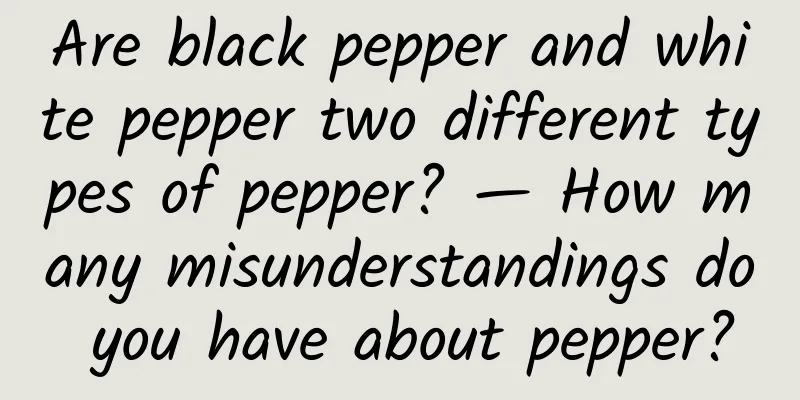Are black pepper and white pepper two different types of pepper? — How many misunderstandings do you have about pepper?

|
Are black pepper and white pepper two different types of pepper? ——How many misunderstandings do you have about pepper? 1. Is pepper native to China? No, pepper is native to India. 1. The origin and legend of pepper Pepper originated in the Western Ghats Mountains of India. It is a world-famous fragrant and spicy spice plant and is known as the "king of spices". Due to its unique fragrant and spicy characteristics, it has been popular in the East and the West throughout history. Especially in medieval Europe, pepper has always been mysterious, attracting Europeans at that time to travel across the ocean to the distant East India to find it, thus opening the Age of Exploration and promoting the rise of global trade. The huge profits brought by the pepper trade made pepper a mysterious existence in the eyes of Europeans. Legend 1 "Seeds of Heaven" The earliest pepper wholesalers, Arab and Venetian merchants, told the Romans that pepper grew in waterfalls guarded by dragons, or was plucked from heaven and was "seeds of paradise." Legend 2: From the Forest Guarded by Venomous Serpents In order to conceal the origin of pepper, the Arabs in the Middle Ages described it in a very mysterious way. They said, "Pepper grows in a forest guarded by poisonous flying snakes, and people usually dare not approach it. Only when the pepper fruits are ripe every year, people will risk great danger and set fire to the forest to drive away these poisonous snakes. The fire drives away the poisonous snakes and also smokes the pepper fruits black, giving them a unique black wrinkled skin and spicy smell. People must harvest pepper in a very short time to avoid revenge from the poisonous snakes." 2. The spread of pepper in China Pepper was introduced to China no later than the Jin Dynasty. It was first introduced as a spice product. Because of its spicy taste and the habit of ancient people to name foreign objects with the character "Hu", it was named "pepper". The earliest record of pepper comes from Sima Biao's "Continued Book of Han" in the Western Jin Dynasty. In his "Biography of the Western Regions", it is recorded that Tianzhu has "various spices, rock honey, pepper, ginger, black salt" and other products. Duan Chengshi, a famous naturalist in the late Tang Dynasty, narrowed the origin of pepper to "from Magadha, called Meiluzhi" in "Youyang Zazu". Magadha was one of the ancient countries in India, and Meiluzhi was the Sanskrit transliteration of pepper. After pepper was introduced to China in the Jin Dynasty, it immediately became a fashionable condiment for the upper class due to its exotic flavor, and also brought new cooking methods. For example, Duan Chengshi recorded in Youyang Zazu: "(Pepper) is similar to Han pepper, very spicy. It is harvested in June, and people now use it in making Hupan meat dishes." In the Tang Dynasty, pepper was so expensive that the amount of pepper one owned represented wealth. As recorded in the New Book of Tang, Yuan Zai, the prime minister of Emperor Daizong of Tang, was arrogant and greedy. After he was ordered to commit suicide by Emperor Daizong of Tang, "his property was confiscated, and five hundred taels of stalactites, and eight hundred stones of pepper were seized". At that time, stalactites and pepper were both very precious medicinal materials and spices. Pepper was a luxury item, which made Yuan Zai collect pepper like money, and this is why it was recorded in the history books that were very frugal. During the Song and Yuan dynasties, with the development of overseas trade, the trade and influence of pepper also expanded. Pepper was a fine product in the Song Dynasty, and was often imported from ports such as Quanzhou and Guangzhou. In the 26th year of Shaoxing (1156), the Kingdom of Srivijaya (located on the island of Sumatra) paid tribute of "10,000 kilograms of pepper". In the Yuan Dynasty, pepper trade and consumption became more prosperous. Marco Polo recorded in his travel notes that Hangzhou "eats 44 dan of pepper every day, and each dan is 223 pounds. Trade has driven the application and development of pepper in China. In the Song Dynasty, it was mainly used for medicinal purposes, and in the Yuan Dynasty, it expanded to edible purposes, but it was still classified as a medicine. Compared with the previous period, the pepper trade in the Song and Yuan dynasties reached a very high level, both in terms of quantity and consumption range, but it still did not complete the transformation from a luxury to a common product. The maritime trade in the Ming Dynasty further flourished, and as the trade volume increased significantly, the price of pepper began to fall. According to statistics, in the late Hongwu period of Zhu Yuanzhang (around 1390 AD), the value of pepper per hundred catties was 20 taels of silver, while by the Xuande period of Zhu Di (around 1420 AD), it was only worth 5 taels of silver. During the reign of Zhu Di, the eunuch Zheng He sailed to the West seven times and visited ports along the Indian coast many times. The huge fleet he led also docked at Calicut (Guri), exchanging a large amount of gold and silver utensils, silk and porcelain for a large amount of pepper. Under the official promotion, the maritime trade in the Ming Dynasty became more prosperous. According to statistics, in the 15th and 16th centuries, China purchased 50,000 bags of pepper (about 2.5 million catties) per year in Southeast Asia, which was equal to the total amount of pepper imported from the East to Europe in the first half of the 17th century. Europeans could only obtain the remaining share after Zheng He's purchase. Therefore, starting from the middle of the Ming Dynasty, the value of spices became lower and lower, and as pepper began to be planted in southern China, pepper eventually became a common item in ordinary people's homes. The introduction and cultivation of pepper in China began in the 1940s. It was first introduced and planted in Wenquan Town, Qionghai City, Hainan by overseas Chinese from Hainan in 1947. It was then gradually expanded to various cities and counties in Hainan as well as Guangdong, Guangxi, Fujian and Yunnan. At present, my country's pepper planting area is about 400,000 mu, and the annual total output is about 40,000 tons. It is mainly planted in Haikou, Wenchang, Qionghai, Wanning, Ding'an and other cities and counties in Hainan, as well as Luchun, Baoshan, Dehong and other places in Yunnan. 2. Does pepper grow on trees? no. Pepper is a climbing vine plant of the genus Piperaceae. In its natural state, it can grow to more than 9 meters by clinging to tall trees. However, in order to facilitate production operations, a pole is usually erected in the field to tie the pepper vines to it, and the height is controlled at about 2-3 meters, so that the pepper grows on vines instead of trees. 3. Are black pepper and white pepper two different types of pepper? no. Black pepper and white pepper are not two different types of pepper, but the same type of pepper, just processed differently. Black pepper is made by directly drying or baking the fresh pepper fruits after picking them. The fresh fruits turn black after drying, hence the name "black pepper". White pepper is made by picking fresh pepper fruits, soaking them in water, and waiting for the peel and pulp to rot. The remaining pepper kernels (seeds) are then rinsed with clean water and dried in the sun or in an oven. The pepper seeds made in this way have a smooth skin and are slightly white, hence the name "white pepper". 4. Black pepper is made from young pepper fruits, so does it mean it is a bad pepper? no. Since pepper was introduced to my country in 1947, Hainan has been the main planting area, accounting for more than 90% of my country's planting area. Most agricultural products in Hainan are difficult to sell due to transportation problems. White pepper is easier to store at home in Hainan's long-term high temperature and high humidity environment than black pepper because the peel and pulp are removed during the processing. Due to the storage characteristics of white pepper, people do not need to rush to sell it when the market price is not good, and can sell it after the market price improves, or sell it when the family is in urgent need of money. It means saving money in the bank, so Hainan people often jokingly call pepper a "cash crop." Because of the characteristics of pepper in Hainan, pepper farmers in Hainan have generally processed fresh pepper fruits into white pepper for a long time. Only a few of them, at the end of pepper picking, must remove all the remaining flowers and fruits on the tree to ensure normal flowering and fruiting in the second year. They will dry all the picked fruits (including old flower spikes and tender fruit spikes, etc.) and process them into black pepper to avoid wasting pepper garden fruits. Therefore, most people who don’t know the truth think that black pepper is processed from tender pepper fruits with poor quality. But in fact, in the world, including Yunnan, my country, more than 80% of the primary processed pepper products are processed from mature fresh pepper fruits into black pepper, only about 15% are added with white pepper, and about 5% are processed into green pepper. Black pepper White pepper 5. Does pepper smell like pig intestines? no. my country's pepper is mostly produced in Hainan. As mentioned above, most pepper farmers in Hainan process pepper fruit into white pepper, but most pepper growers in Hainan are mainly planted in a decentralized manner. Each family's planting area is not large, and because the overall economic value of pepper is high, in order to prevent theft, most pepper growers use small water tanks or pools at home, put fresh pepper fruit in plastic bags, put them into water tanks or pools and soak them, and do not change water every day for water conservation, until five or six days later, after the pepper fruit in the bag rots, it is taken out for cleaning, because the soaking time is long and the pepper peel and pulp rot, a large amount of black water and stink are produced, so the processed white pepper has a thicker rotten smell, especially like the taste of pig intestines that are not cleaned. In fact, according to my country's white pepper processing standard, this kind of white pepper product belongs to unqualified white pepper product, and qualified white pepper product should have strong pungent taste and spicy flavor. However, for a long time, Hainan pepper has been difficult to sell due to transportation problems, resulting in Hainan pepper being mostly sold in large orders. In the case of large orders, buyers often ignore the quality differences of the products in order to complete the orders, causing most growers to be accustomed to traditional non-standard processing methods for white pepper, giving mainland people the illusion that pepper has a smell. 6. Is the pepper we eat in restaurants pure pepper? uncertain. Pepper is a famous and traditional condiment. For convenience, it is mostly ground into pepper powder and sold in seasoning bottles. However, in order to save costs, the pepper powder in the seasoning bottles we usually use is mostly prepared pepper powder, which is ground with a small amount of pepper grains and other seasonings. Generally, the pure pepper content in prepared pepper powder is less than 20%. This is why we can hardly smell the unique strong spicy taste of pepper when seasoning meals. A large amount of pepper powder must be added to the dishes to have the unique aroma of pepper. Author: Wu Huasong (Institute of Tropical Crops Germplasm Resources, Chinese Academy of Tropical Agricultural Sciences) |
Recommend
How to determine whether the Xiaohongshu account has been restricted? Xiaohongshu’s flow limiting solution!
Children, do you have a lot of questions while op...
Mango TV's three killer features in accelerating the OTT market
After the industry reshuffle in 2014, the OTT box...
iOS 17 update, major features return!
Early this morning, Apple pushed the iOS 17 beta ...
Changan Oushang X7 PLUS interprets technological equality, 100,000-class SUV enjoys 300,000-class smart cockpit
The automotive industry is in a period of great c...
How does Baodao Glasses reconstruct its private domain operations?
It is said that private domain operation is a top...
Momo’s paying users have surged. What’s the operational growth logic behind it?
When it comes to Momo, many people still think of...
Oxalis vs Oak: False Clover? Oak? The Cultural Adventures in Plant Names
The Chinese names of plants are like refined code...
The longer the time, the better the effect? Don’t wear steam eye masks blindly!
Reviewer: Liu Dongbao Chief Physician of Ophthalm...
How much does it cost to rent a server in Shanghai IDC computer room for one year?
Shanghai is a first-tier city in China, where hou...
Lenovo takes the lead: Can Challenger Motorcycle be reborn?
[[127123]] Dong Jun At 3 pm on February 26, 2015,...
Tencent still needs to rely on third parties to support WeChat
At the Tencent Global Partner Conference held two...
Microsoft's new plan: developing games for augmented reality device HoloLens
Phil Spencer, head of Microsoft's Xbox divisi...
Apple is going to build a car again? Apple SPG gathers a lot of former car companies
Recently, Doug Field, former senior vice presiden...
Summary of predictions for new products at Apple's conference tonight
[[148415]] Apple will hold a new product launch e...









